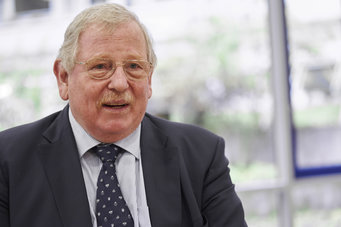“A wonderful confirmation of our observations”
Reinhard Genzel of the Max Planck Institute for Extraterrestrial Physics on the first image of the galactic centre
With the Event Horizon Telescope (EHT), researchers have successfully imaged the black hole at the centre of the Milky Way. To do this, they connected the radio antennas of eight observatories worldwide. Reinhard Genzel, Director at the Max Planck Institute for Extraterrestrial Physics in Garching, has been studying this region at the heart of the galaxy for more than three decades. This is done in infrared light with the Very Large Telescope of the European Southern Observatory. There, he and his team track the movement of stars that buzz around the invisible object like moths around light. In this interview, Genzel, who was awarded the 2020 Nobel Prize in Physics for these observations together with Andrea Ghez of the University of California, discusses the latest result of the EHT collaboration.

How do you assess the image of the galactic centre against the background of your own measurements?
Reinhard Genzel: The image is a nice result and a wonderful confirmation of our ultra-precise observations in infrared light. From the orbital motion of stars around the black hole Sagittarius A*, we determined its mass to an accuracy of 0.1% and its distance from Earth to an accuracy of 0.2%. From this, we deduced that the shadow of the black hole must have a radius of 26 microarcseconds. The size of the shadow measured by EHT colleagues agrees quite well with this prediction when taking into account the measurement errors. The event horizon of the object has a radius of 10 microarc seconds; this angle corresponds to a one-euro coin on the moon. This value also agrees quite well with the model of a black hole with the mass of four million suns determined by the VLT and Keck teams.
What can be derived from this data?
Together with what we knew already, we can now confidently rule out many speculations that include alternative physical explanations for a black hole. These include mass concentrations composed of heavy bosonic or fermionic elementary particles of the same mass as the black hole but with a much larger diameter, or extremely dense star clusters that mass together at the heart of the Milky Way.
How do your observations differ from those with the Event Horizon Telescope?
Although we also use interferometry – the superposition of light – we work in the infrared range with an instrument called Gravity, which is mounted on the Very Large Telescope Interferometer of the European Southern Observatory. Of course, its angular resolution is not as high as the Event Horizon Telescope, which is practically a virtual telescope the size of the Earth. But that also has its advantages. For example, we were able to observe the fluctuations in brightness of the gas swirling around the black hole at a short distance. However, for the Event Horizon Telescope with its enormously high angular resolution of 20 microarcseconds, this was a problem because the images become blurred due to the constant variability of matter.
First your results, now the image – you’d think there was nothing left to observe…
Not at all! For example, we would like to know how fast the black hole rotates. In other words, what its spin is. That cannot be deduced from the image. The inclination of the plane of rotation also remains uncertain.
Why is knowledge of these variables important?
General relativity says that black holes are characterized only by mass and angular momentum or spin. In addition, the no-hair theorem applies to these objects. This means that a black hole has no local structure at the event horizon, its interface. In short: if you know the two quantities mass and spin, you are done. You have completely described the black hole.
Would all the mysteries then be solved?
Not quite. Because according to the theory, a singularity exists in the core of a black hole. According to relativity theory, this is a point with infinitely high density where space-time is no longer defined. This singularity is not accessible, and I don’t see how it could ever be studied now or in the future. I must therefore pass on this problem.
The interview was conducted by Helmut Hornung.












